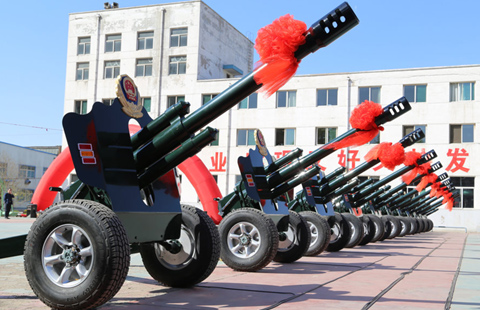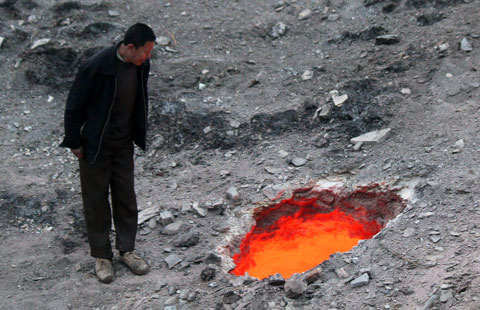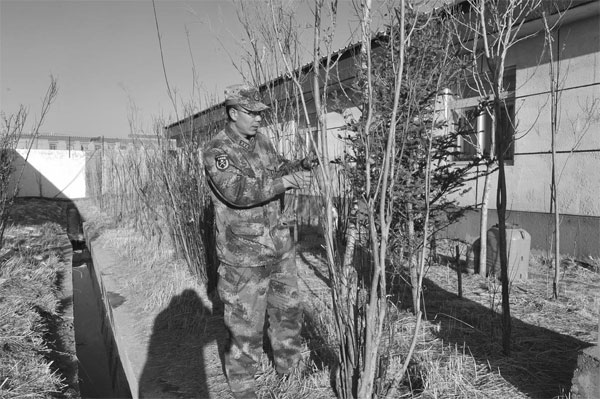Army technician helps trees in battle of survival
Updated: 2015-04-10 12:19
By Palden Nyima and Phuntsog Tashi in Lhasa(China Daily USA)
|
|||||||||
Zhao Zexiao's planting efforts yield success, growing reputation in Naqu
Trees are something of a rarity in the Tibet autonomous region. Conditions on the high altitude plateau of the Naqu Grassland - 4,500 meters above sea level - are not conducive to their growth, except for a few places in eastern Naqu prefecture.
Many of the nomads who inhabit the area had seldom seen a tree in their life until recently, when the remote places of the region were linked by roads and modern communications.
Tsering Chukyi, a nomadic woman from Amdo county in northern Tibet, did not see a tree until 1998 at the age of 10.
"I had never seen what a tree looked like until my parents took me to Lhasa, where I saw trees for the first time in my life," said the 27-year-old.
"I was very excited and pleased to see trees, and I thought a place with trees is a very beautiful place."
President Xi Jinping made reference to encouraging tree planting in Tibet in a recent Central Party School seminar. Xi told of one of his experiences when he was Party secretary of Fujian province and made a survey trip to Tibet's Naqu prefecture with several Tibetan officials.
Xi said the local government had increased the award for planting a tree that survived in Tibet from several thousand yuan to more than 100,000 ($16,350) but no one ever received the award. Eventually, people gave up on planting trees.
Despite the failures, Zhao Zexiao has continued since the 1990s to explore ways of making it possible for planted trees to survive at such a high altitude.
Zhao, an agriculture technician in the Naqu Division of the People's Liberation Army, has a PhD in microbiology from the Third Military Medical University.
His hard work has paid off. Since 2012, he has planted more than 5,300 trees; 200 of those have survived for three years and 280 others for two years. He is pretty confident of his trees surviving longer.
Zhao's success is due to the types of trees he is planting - Tibetan junipers, Qinghai spruce, and Tibetan poplars, which have a better chance of surviving the harsh conditions.
"By planting trees in high altitude places of Tibet, I want to make a small contribution to the fragile environment and fighting desertification," said Zhao.
The 42-year-old said he wants to make Tibet a better place with more azure sky, cleaner water, fresher air and more verdant hills.
Zhao's name and his spirit of perseverance have spread across the grassland and Tibet.
Naqu Middle School plans to invite him to supervise its tree planting project this month.
"I feel lucky to have met Mr Zhao," said Losang, the school's headmaster. "He has volunteered to help us to plant trees at our school."
Tashi Tsering, 51, a professor of environmental studies at the College of Science at Tibet University, said Zhao "is very persistent with his career, and we believe his success can have great academic value in the areas of city greening and fighting against desertification".
Zhao has set up an experimental station in Qushul county to tackle tree planting along the Lhasa River and areas of desertification in Tibet.
|
Zhao Zexiao, an agriculture technician in the Naqu Division of the People's Liberation Army, checks on the saplings he has planted on an experimental field in Naqu, Tibet autonomous region. Palden Nyima / China Daily |
(China Daily USA 04/10/2015 page5)

 Ten photos you don't wanna miss of today
Ten photos you don't wanna miss of today
 Amur tigers come back from the brink
Amur tigers come back from the brink
 Guns prepared to mark Anti-Fascist War anniversary
Guns prepared to mark Anti-Fascist War anniversary
 Tibetans' viral wedding photos contrast city with country life
Tibetans' viral wedding photos contrast city with country life
 Strange but true: Three times a lady
Strange but true: Three times a lady
 Road to Cuba
Road to Cuba
 Trending: 'Gateway to hell' found in Urumqi
Trending: 'Gateway to hell' found in Urumqi
 Last batch of Chinese peacekeeping infantry arrives in S.Sudan
Last batch of Chinese peacekeeping infantry arrives in S.Sudan
Most Viewed
Editor's Picks

|

|

|

|

|

|
Today's Top News
US, Cuba hold highest-level talks since 1961
UN official praises new website that engages Chinese public
Hillary Clinton expected to announce presidential run soon
Shooting outside Washington DC leaves 1 injured
Blocking of chip exports could backfire: scientist
US to help China fight tough TB strain
Rush for H-1B visas is on
Tibetan lawmaker meets US Rep
US Weekly

|

|








